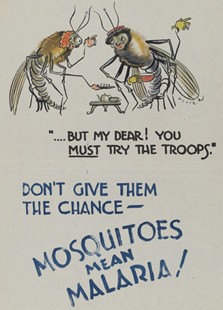 Continuing on with our promised examination of DDT’s usefulness in the War on Malaria, we’re gonna turn our gaze southward this morning. As carefully detailed here, Mexico was a longtime heavy user of DDT, sloshing out 70,000 tons of the controversial chemical between 1959 and 1999. Then the nation resolved to phase out DDT entirely, and instead employ other means of combating malaria. Chief among these new tactics was a focus on eliminating mosquito breeding grounds—something that was much more achievable in practice than it might seem on paper. From a 2003 paper from the International Journal of Hygiene and Environmental Health (paywalled):
Continuing on with our promised examination of DDT’s usefulness in the War on Malaria, we’re gonna turn our gaze southward this morning. As carefully detailed here, Mexico was a longtime heavy user of DDT, sloshing out 70,000 tons of the controversial chemical between 1959 and 1999. Then the nation resolved to phase out DDT entirely, and instead employ other means of combating malaria. Chief among these new tactics was a focus on eliminating mosquito breeding grounds—something that was much more achievable in practice than it might seem on paper. From a 2003 paper from the International Journal of Hygiene and Environmental Health (paywalled):
Beginning in 1999, the NMCP identified localities with a high incidence of malaria along the Oaxaca coast and trained volunteers from these communities to identify and assess the conditions of breeding sites. These volunteers also mobilized community members to clean the streambeds and eliminate the green algae on a monthly basis. The trained volunteers learned to record the presence of algae, trash, and larvae and to maintain records on the effects of the cleanup efforts. Based on the two kilometer flight range of A. pseudopunctipennis, clean-up activities are concentrated in a two-kilometer range from the perimeter of the inhabited communities. Over a three year period, these measures have resulted in a 70 percent decrease in larval densities and more than an 80 percent reduction in adult mosquitoes.
Combined with a revamped drug treatment regimen that ratcheted down the number of humans carrying the parasite, Mexico was able to make malaria virtually disappear within four years: Cases fell from roughly 17,900 in 1998 to just 254 in 2002.
We don’t think the Mexican success story necessarily proves that DDT has no role in fighting malaria. The nation obviously benefited from its relative wealth, which translated into a central government with the money and expertise required to see through changes in Oaxaca. Spraying DDT is obviously a heckuva lot easier than getting poor communities to rid their water of algae every month. But shortcuts do have consequences.
(Image via the National Army Museum)


Captured Shadow // Jun 7, 2010 at 12:24 pm
When I was living in Sri Lanka I had a local public health team come by my place looking for standing water where mosquitoes breed. There was a local outbreak of Dengue and they wanted to keep it from spreading. It is a great approach in areas where labor is cheap.
Jordan // Jun 7, 2010 at 1:52 pm
That would seem well adapted to a place like India. Their rural work scheme where everyone in guaranteed at least 100 days of paid labor by the government could be mobilized to deal with mosquito breeding grounds.